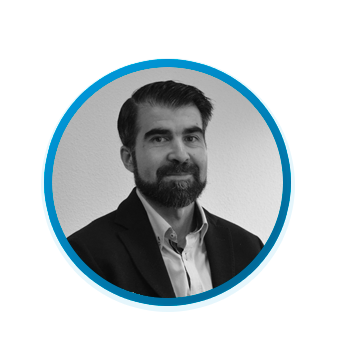Smart ESI: A new School model
By Soledad Escolar Deputy Director of Academic Planning and Smart ESI.
In the 80s, Mark Weiser, considered the father of ubiquitous computing, referred to it for the first time as the tendency to integrate technology into people's daily lives, so that it became omnipresent (in any location). , format and time) and indistinguishable from technology explicit that people use (mobile phones, tablets, laptops, etc.) [1]. This paved the way towards the search for user interfaces that would allow interaction with an embedded system, that is, an electronic device embedded in another larger device, for example a television, a refrigerator or a scooter. The underlying technologies that support ubiquitous computing include microelectronics, communications, distributed systems, and user interfaces, among others.
Twenty years later, Kevin Asthon, best known for creating the global RFID (Radio Frequency IDentification) identification system, coined the term Internet of Things (IoT) to refer to devices (things ) who had been empowered by giving them the means to see, hear and smell the world [2]. There is a very significant change with this vision that represents technology at the service of people without people. No interaction needed explicit with ubiquitous technology, but it is autonomous (to a greater or lesser extent, given that the term is very broad: self-management, self-adaptation, self-protection, self-repair and self-optimization) and with the capacity for computing , processing, data analysis, communication, reasoning, decision and action. Home automation provides us with a classic example: if I am at home, it is winter, it is 18.00:XNUMX p.m. and the light level outside falls below a threshold, the lights will be activated, the blinds will be lowered and the heating will be turned on. will light up. The underlying technologies that support this vision now extend, in addition to those already mentioned, to the processing of massive data from multiple sources, computing in the edge or in the cloud, Artificial Intelligence (AI) techniques or Data Science.
The IoT has broken into multiple vertical domains such as cities, agriculture, homes or industry; in all of them to increase the level of knowledge that people have about that environment through the observation of a large number of phenomena and appropriate action. It has also broken into transversal domains, such as energy efficiency or digitalization. These domains are assigned default the prefix “smart”: smart city, smart industry, smart home, etc. The scientific community does not, however, have a consensus on what property or properties confer intelligence to the IoT. In the area of smart cityFor example, the condition of smart can be purchased simply by adopting actions aimed at increasing the degree of urban development, for example, initiatives such as granting subsidies to replace polluting cars, replacing streetlight bulbs with LEDs or building more kilometers of bicycle lanes [3]. Are these initiatives sufficient to provide the intelligent character to the domain? City? Clearly not: Information and Communication Technologies (ICT) need to be incorporated as part of the materialization of the intelligent domain. On this there does seem to be consensus in the scientific community.
Similar to the field of smart cities, there is also no agreement on the definition of the term smart university (smart university) and it is also generally accepted that it differs from the traditional university in the use of ICT, including automation, control and management systems, AI or IoT to fulfill the mission of the institution. Another example is found in the field of smart buildings (smart buildings). According to Benavente-Peces [4], a smart building is a set of technologies that allow the different objects, sensors and functions of a building to communicate and interact with each other, as well as be managed in a controlled and automated way from a distance. The management of buildings is extremely important since they represent one of the most critical infrastructures in both cities and universities, because they concentrate the greatest expenditure on public services such as electricity, water or gas. According to Directive 2010/31/EU [5] energy consumption in buildings represents one of the largest shares of total consumption, around 40% in the EU, which, in order to alleviate this problem, has promoted policies in the last 50 years that have been progressively converging on the concept of Almost Zero Energy Buildings, in English Near Energy Zero Buildings (NEZB), which are buildings with a very high level of energy performance and that require almost zero or very low amounts of energy that can be covered, to a large extent, by energy from renewable sources.
To get closer to the concept of NEZB, in the state of the art [6] multiple strategies have been proposed for energy saving in smart buildings through the automation and optimization of, for example, lighting, HVAC (Heat and Ventilation Air Conditioning), fire prevention and air quality systems. Such systems are typically composed of devices that integrate multiple sensors (e.g. PIR[CB1] [MD2] , temperature, humidity, CO2, PMs or suspended particles, LEDs) and actuators (e.g. solenoid valves)[CB3] [MD4] and that implement user services based on AI techniques such as neural networks, agents or fuzzy logic to determine which user behaviors, subject to environmental conditions and the state parameters of the installation, incur energy consumption. superfluous and how to adjust the system settings accordingly to optimize its consumption while maintaining user safety and comfort. A very simple example would consist of simply observing the occupancy of spaces and monitoring users to determine when the lights in a room should be turned on and off.
The project smart ESI arose as an initiative of the Director of the Center, Crescencio Bravo, who in his electoral program proposed converting the Higher School of Informatics (ESI) into a smart school (smart faculty), which would use the entire infrastructure of the center as a model to build a model of an intelligent university center on which a set of advanced and specialized services is defined, aimed at increasing our knowledge about the School and its environment, and with the ultimate objective to improve its operation, sustainability and efficiency. Thus, with the Smart ESI project, led by the Subdirectorate of Academic Planning and Smart ESI, we carry out the smartification of our School, providing it with the technological means necessary to realize the concept of smart university. In its design we proposed that this smartification process be:
- cross, based on the collaboration of the ESI research groups represented through the Smart ESI and Digital Services Commission; [CB5] [MD6]
- transparent, through the use of open data that can be consulted by the university community (professors, PAS, students);
- scalable, so that it can grow gradually through micro-deployments that are easily integrated into the project;
- measurable, which allows progress to be quantified thanks to a set of indicators;
- hyper-technological, that makes use of cutting-edge technologies (not in vain is ESI a technology school) and
- based on the paradigm of services that provide added value, relevant, advanced and specific services for heterogeneous users.
In the design of the smart ESI project, the following two smart dimensions were taken into account, each of which addresses a strategic area for the School:
- smart environment: services aimed at optimizing the use of the School's resources, which pursue a more efficient, sustainable and clean environment. This includes the transformation of buildings into smart ones through devices that allow the monitoring of variables of interest, such as electricity, water or gas consumption, classroom temperature and humidity, and CO levels.2, etc., as well as the action on the radiators to control the temperature by means of solenoid valves.
- smart management: services aimed at improving the operation and functioning of our School, including the management of parking spaces (smart parking[CB7] [MD8] ), the participation of users in the communication of incidents, the introduction of location services, the accurate counting of people in buildings and the presence in classrooms.
At the time of writing these lines, a total of 59 devices have been installed in the ESI (Figure 1):
- 4 Elsys ERS CO2 in module B classrooms (A1.1, A1.2, A2.1, A2.2) that measure temperature and humidity, CO level2, luminosity, movement. The elsys transmit this information every 10 minutes through LoRa technology to a LoRa receiving antenna (Milesight LoRaWAN Gateway UG67) located in the False ceiling [CB9] [MD10] of the Fermín Caballero Building and which also acts as a gateway between LoRa and Ethernet.
- 14 Shelly Plus H&T that measure temperature and humidity every hour and transmit their data wirelessly via WiFi using the MQTT protocol. The shelly have been installed in classrooms F0.1, F0.2 and F1.1, laboratories LD1, LD2, LD3 and LD4, the Assembly Hall, the Degree Hall, the Anita Borg room, the Calculation Center and the hallways of floors 1, 2 and 3 of the Fermín Caballero Building.
- 4 Shelly TRV that will soon be installed in the hot water radiators located in laboratories LD2, LD3 and LD4 and in classroom F1.1. These solenoid valves or thermostatic valves are capable of regulating the flow of water that circulates through the radiator so that the temperature can be controlled.
- An MCF-LW12TERPM weather station from the Italian manufacturer Enginko, located on the terrace of the third floor of the Fermín Caballero building that measures outdoor temperature and humidity, barometric pressure and concentration of particles related to the level of pollution (PM1, PM2.5 and PM10 ). The station incorporates a small solar panel so it does not need batteries, it captures data every 15 minutes and transfers it via LoRa to the receiving antenna. The measurements are compared with those of the AEMET to check their precision (figure [CB11] 2).
- A measurement concentrator or datalogger Sennet IoT DL271 plus two extenders [CB12] [MD13] Sennet IoT Xtend M6 designed and manufactured by the Spanish company Satel Ibérica. These are very professional, versatile and robust devices, intended for tertiary and industrial buildings and designed to operate in multiple failure situations. With them we can take data from a total of 15 three-phase analyzers that allow us to completely monitor consumption in buildings A and B, in the Fermín Caballero building (individually monitoring its four floors) and in the Calculation Center, one of the ESI spaces that consume the most energy.
- 4 Bosch brand parking sensors that measure the occupancy of parking spaces (in the outermost row, in the center) and transmit it via LoRa to the receiver.
- A Parametric PCR2 people counting sensor based on infrared that allows us to measure the flow of people that crosses the entrance door of the Fermín Caballero Building and transmits data via LoRa with a frequency of 15 minutes.
- 28 NFC tags, distributed in strips of 7 tags each, installed in the 4 classrooms of module B to represent 7 possible incidents (Figure 3): teaching computer, thermostat, furniture, screen, projector, sensor elsys or others. A has been provided app to read the label corresponding to the detected incident and notify it in real time to the technical staff for early resolution.



All data captured by the sensors is stored on the server smartesi located in the Calculation Center. The server implements the Chirpstack+MQTT+MariaDB+Home Assistant software stack to enable integration of data from different networks, persistence and visualization. Home Assistant is the automation software that we have selected to act as a controller, allowing bidirectional communication through multiple technologies and the creation of dashboards customized for viewing information through any web browser. In the Web page http://smartesi.uclm.es:8123/ You have very valuable information at your disposal that you can use for different purposes (you must be connected to eduroam or the VPN and use the username/password provided).
La smart ESI continues to grow: before the end of 2023 we will have deployed two more sensors: the EM300-DI pulse sensor to measure our gas consumption and the AM107 sensor to measure indoor air quality, both from the manufacturer Milesight and based on LoRa technology. The occupancy of the classrooms provides very useful information to be able to correctly manage the temperature of the classrooms and avoid superfluous expenses that imply an increase in energy consumption. Also on our task list is the control of luminaires based on schedules and occupancy to reduce consumption: this will be one of our priorities this year. We are currently working on a location application aimed at both external visitors and students who want to find a teacher's office. These are just a few examples of works in progress.
I don't want to forget the solar tree, a very nice project that we thought up a long time ago and which consists of deploying a photovoltaic infrastructure in the shape of a tree, intended to be a demonstrator of the production of electrical energy, a monitoring system and a recreational space for everyone. . This project has not been abandoned but delayed while waiting to find adequate financing.
In the academic field, in the 2022/23 academic year, several TFGs have been launched whose themes are aligned with the smart ESI project. One of these works has recently received a prize in the Third Edition of the Turing Machine Awards for the best TFG in the field of embedded systems, awarded by the Aula Ubótica-UCLM.
Finally, I want to remind you that the smart ESI project is a project open to the participation of the ESI community and that you can contribute with your ideas to create this new model of School that we would all like to have.
This opinion article is based on the article recently published in Buildings magazine [7].
--------------
Acknowledgements: The smart ESI project is a joint effort of several working groups without which its development would not be possible: I would like to thank the School's technical team for its involvement in the project, in all the infrastructure management and maintenance tasks; to Fernando Rincón, for enabling the deployment of 200 smart lights provided at no cost by the company Zemper; to our colleague Pepe Bravo, for his collaboration and initiative to “grow” smart ESI through several applications based on NFC technology that enable multiple useful functionalities for the ESI community; to the Office of Infrastructure Management (OGI) and the ICT Services of the UCLM.
[1] Mark Weiser. 1999. The computer for the 21st century. SIGMOBILE Mob. Comput. Commun. Rev. 3, 3 (July 1999), 3–11. https://doi.org/10.1145/329124.329126 [2] Ashton, K. That 'Internet of Things' Thing. RFID J. 1999, 22, 97–114. [3] Escolar, S., Villanueva, FJ, Santofimia, MJ, Villa, D., Toro, XD, & López, JC (2019). A Multiple-Attribute Decision Making-based approach for smart city rankings design. Technological Forecasting and Social Change. [4] Benavente-Peces, C. On the Energy Efficiency in the Next Generation of Smart Buildings—Supporting Technologies and Techniques. Energies 2019, 12, 4399. [5] Directive 2010/31/EU of the European Parliament and of the Council of May 19, 2010 on the Energy Efficiency of buildings. Available online: https://www.boe.es/doue/2010/153/L00013-00035.pdf [6] Metallidou, C.K.; Psannis, K.E.; Egyptiadou, EA Energy Efficiency in Smart Buildings: IoT Approaches. IEEE Access 2020, 8, 63679–63699 [7] Escolar, S.; Rincón, F.; Barba, J.; Caba, J.; de la Torre, JA; López, JC; Bravo, C. A Methodological Approach for the Smartification of a University Campus: The Smart ESI Use Case. Buildings 2023, 13, 2568. https://doi.org/10.3390/buildings13102568










